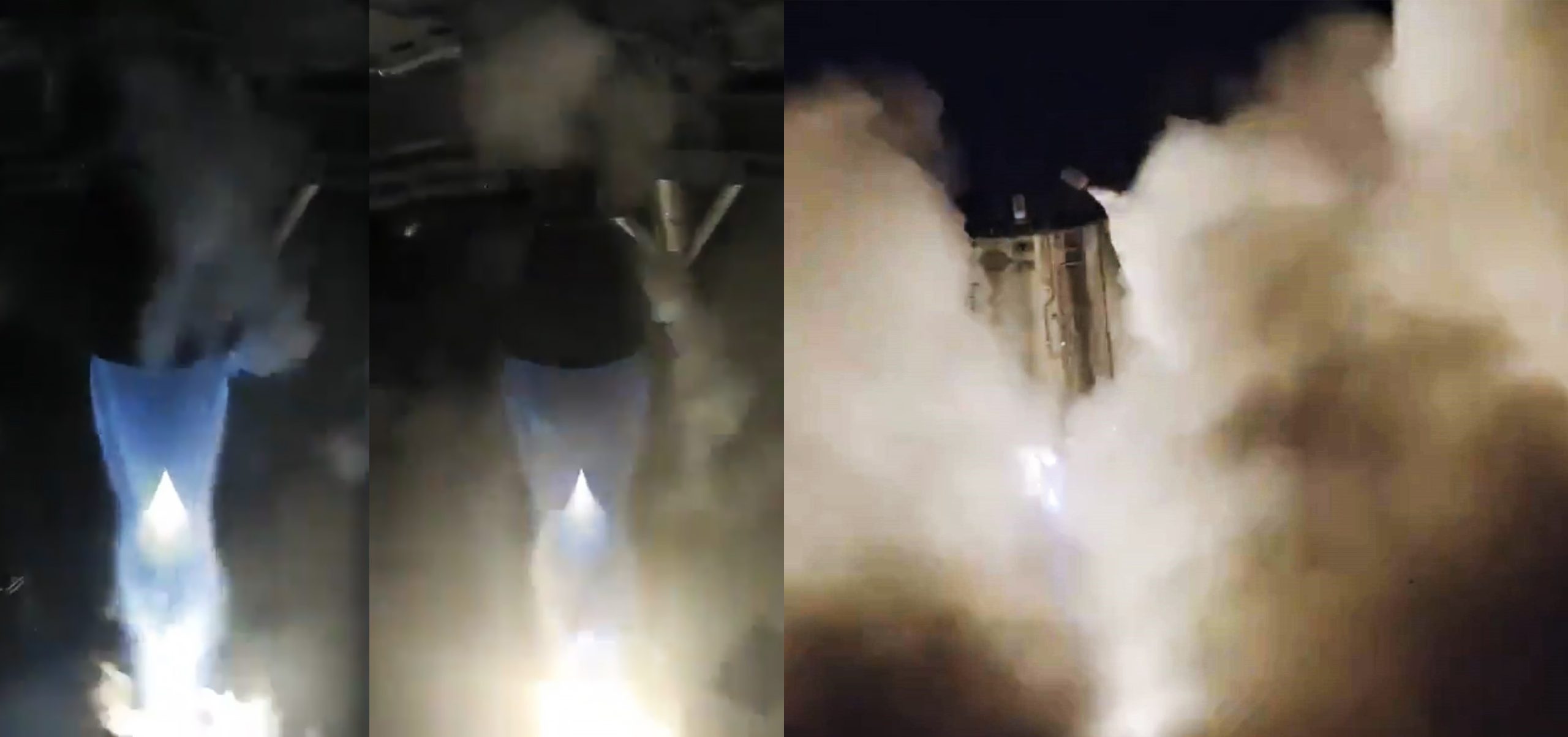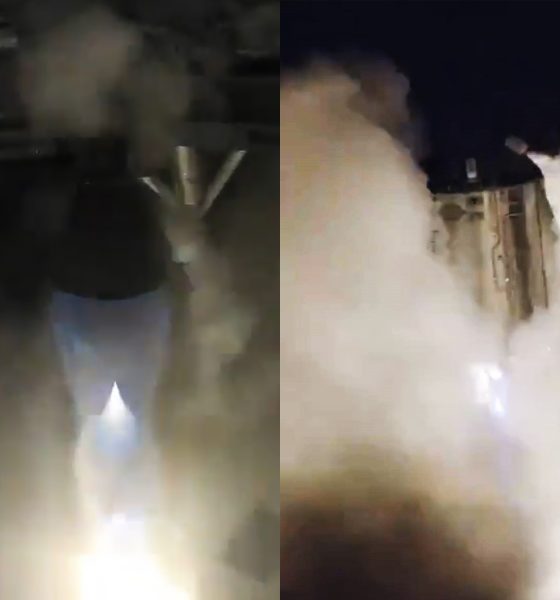

News
SpaceX CEO Elon Musk posts uncut Raptor, drone videos of Starhopper’s flight test debut
Some two hours after Starhopper’s inaugural untethered flight, SpaceX CEO Elon Musk took to Twitter to post an uncut video showing the ungainly rocket’s launch and landing from the perspective of both a drone and Starhopper’s lone Raptor engine.
As noted by commenters, Starhopper’s first flight also marks perhaps an even more fascinating milestone: it’s technically the first launch ever of a full-flow staged-combustion (FFSC) rocket engine. Whether or not the development hell Raptor required is or was worth it to SpaceX, the company has become the first and only entity on Earth to develop and fly a FFSC engine, beating out the national space agencies of both the United States and Soviet Union, both of which built – but never flew – prototypes.
Instead of inexplicably shelving a mature prototype development and test program, SpaceX iterated through several subscale Raptor prototypes, test-fired the engines for more than 1200 seconds total, used that data to design and build full-scale Raptors, and finally sped into a hardware-rich test campaign with six (soon to be seven) new engines. After SpaceX settled on a full-flow staged-combustion cycle and methane/oxygen (methalox) propellant, Raptor conducted its first full-scale tests all the way back in 2014, performing preburner flow and ignition tests at NASA’s Stennis Space Center.
Two years and many additional subcomponent tests later, SpaceX successfully performed the inaugural static fire test of its first completed subscale Raptor, a huge milestone for any rocket engine. In the 12 months following its first static fire (September 2016), SpaceX performed dozens of static fire tests with several subscale engines, putting the new propulsion system through >1200 seconds of combined testing.
A year after that, SpaceX was still testing subscale engines but the first full-scale Raptor engine was just a few months away from completing assembly in Hawthorne and heading to McGregor to kick off full-scale static fire testing. Indeed, four months after CEO Elon Musk’s September 2018 update, Raptor serial number 01 (SN01) shipped to Texas in late January and successfully ignited for the first time on February 3rd. SpaceX’s finalized full-scale Raptor engine is designed to produce more than 2000 kN (450,000 lbf, 200 tons) of thrust at full-throttle.
Since that inaugural ignition, SpaceX’s propulsion team – perhaps to their detriment, under orders from Musk – pushed SN01 and several of its successors to their limits as quickly as possible, resulting in severe, irreparable damage in several cases. On the other hand, the no-holds-barred, ‘hardware-rich’ (i.e. destructive) test program has allowed SpaceX to relatively quickly solve several major bugs that prevented the engine from passing longer test fires.
Raptor SN05 was originally expected to support Starhopper’s first flight(s) but had to be passed up after suffering damage in one of its final June 2019 acceptance tests. Raptor SN06 became the first engine – likely thanks to tweaks afforded by data gathered from its failed brethren – to pass all of those acceptance tests, leading to its eventual installation on Starhopper in early July.
Raptor’s impressive development culminated on July 25th with the engine’s first untethered flight while attached to Starhopper, a 9m-diameter (30 ft) low-fidelity prototype that is more or less a mobile test stand for the next-generation SpaceX engine. Raptor is now the only FFSC engine in history that has powered a flight-capable vehicle’s launch and landing, even if said flight featured an apogee of just 20-30 meters (65-100 ft).
“In full-flow staged combustion (FFSC), even more complexity is added as all propellant that touches the engine must necessarily end up traveling through the main combustion chamber to eke every last ounce of thrust out of the finite propellant a rocket lifts off with. As such, FFSC engines can be about as efficient as the laws of physics allow any given chemical rocket engine to be, at the cost of exceptional complexity and brutally difficult development.“
SpaceX delays Starhopper’s first flight a few days despite Raptor preburner test success
For more on what exactly makes full-flow staged-combustion engines uniquely capable and challenging to develop, the subject has been covered at length in past Teslarati articles.
According to Musk, the next major challenge facing Starhopper and (presumably) Raptor SN06 is far more ambitious 200-meter (650 ft) hop and flight test that could happen as soon as the first half of August.
Check out Teslarati’s Marketplace! We offer Tesla accessories, including for the Tesla Cybertruck and Tesla Model 3.

Elon Musk
Elon Musk confirms xAI’s purchase of five 380 MW natural gas turbines
The deal, which was confirmed by Musk on X, highlights xAI’s effort to aggressively scale its operations.

xAI, Elon Musk’s artificial intelligence startup, has purchased five additional 380 MW natural gas turbines from South Korea’s Doosan Enerbility to power its growing supercomputer clusters.
The deal, which was confirmed by Musk on X, highlights xAI’s effort to aggressively scale its operations.
xAI’s turbine deal details
News of xAI’s new turbines was shared on social media platform X, with user @SemiAnalysis_ stating that the turbines were produced by South Korea’s Doosan Enerbility. As noted in an Asian Business Daily report, Doosan Enerbility announced last October that it signed a contract to supply two 380 MW gas turbines for a major U.S. tech company. Doosan later noted in December that it secured an order for three more 380 MW gas turbines.
As per the X user, the gas turbines would power an additional 600,000+ GB200 NVL72 equivalent size cluster. This should make xAI’s facilities among the largest in the world. In a reply, Elon Musk confirmed that xAI did purchase the turbines. “True,” Musk wrote in a post on X.
xAI’s ambitions
Recent reports have indicated that xAI closed an upsized $20 billion Series E funding round, exceeding the initial $15 billion target to fuel rapid infrastructure scaling and AI product development. The funding, as per the AI startup, “will accelerate our world-leading infrastructure buildout, enable the rapid development and deployment of transformative AI products.”
The company also teased the rollout of its upcoming frontier AI model. “Looking ahead, Grok 5 is currently in training, and we are focused on launching innovative new consumer and enterprise products that harness the power of Grok, Colossus, and 𝕏 to transform how we live, work, and play,” xAI wrote in a post on its website.
Elon Musk
Elon Musk’s xAI closes upsized $20B Series E funding round
xAI announced the investment round in a post on its official website.

xAI has closed an upsized $20 billion Series E funding round, exceeding the initial $15 billion target to fuel rapid infrastructure scaling and AI product development.
xAI announced the investment round in a post on its official website.
A $20 billion Series E round
As noted by the artificial intelligence startup in its post, the Series E funding round attracted a diverse group of investors, including Valor Equity Partners, Stepstone Group, Fidelity Management & Research Company, Qatar Investment Authority, MGX, and Baron Capital Group, among others.
Strategic partners NVIDIA and Cisco Investments also continued support for building the world’s largest GPU clusters.
As xAI stated, “This financing will accelerate our world-leading infrastructure buildout, enable the rapid development and deployment of transformative AI products reaching billions of users, and fuel groundbreaking research advancing xAI’s core mission: Understanding the Universe.”
xAI’s core mission
Th Series E funding builds on xAI’s previous rounds, powering Grok advancements and massive compute expansions like the Memphis supercluster. The upsized demand reflects growing recognition of xAI’s potential in frontier AI.
xAI also highlighted several of its breakthroughs in 2025, from the buildout of Colossus I and II, which ended with over 1 million H100 GPU equivalents, and the rollout of the Grok 4 Series, Grok Voice, and Grok Imagine, among others. The company also confirmed that work is already underway to train the flagship large language model’s next iteration, Grok 5.
“Looking ahead, Grok 5 is currently in training, and we are focused on launching innovative new consumer and enterprise products that harness the power of Grok, Colossus, and 𝕏 to transform how we live, work, and play,” xAI wrote.
Investor's Corner
Tesla gets price target bump, citing growing lead in self-driving

Tesla (NASDAQ: TSLA) stock received a price target update from Pierre Ferragu of Wall Street firm New Street Research, citing the company’s growing lead in self-driving and autonomy.
On Tuesday, Ferragu bumped his price target from $520 to $600, stating that the consensus from the Consumer Electronics Show in Las Vegas was that Tesla’s lead in autonomy has been sustained, is growing, and sits at a multiple-year lead over its competitors.
CES 2026 validates Tesla’s FSD strategy, but there’s a big lag for rivals: analyst
“The signal from Vegas is loud and clear,” the analyst writes. “The industry isn’t catching up to Tesla; it is actively validating Tesla’s strategy…just with a 12-year lag.”
The note shows that the company’s prowess in vehicle autonomy is being solidified by lagging competitors that claim to have the best method. The only problem is that Tesla’s Vision-based approach, which it adopted back in 2022 with the Model 3 and Model Y initially, has been proven to be more effective than competitors’ approach, which utilizes other technology, such as LiDAR and sensors.
Currently, Tesla shares are sitting at around $433, as the company’s stock price closed at $432.96 on Tuesday afternoon.
Ferragu’s consensus on Tesla shares echoes that of other Wall Street analysts who are bullish on the company’s stock and position within the AI, autonomy, and robotics sector.
Dan Ives of Wedbush wrote in a note in mid-December that he anticipates Tesla having a massive 2026, and could reach a $3 trillion valuation this year, especially with the “AI chapter” taking hold of the narrative at the company.
Ives also said that the big step in the right direction for Tesla will be initiating production of the Cybercab, as well as expanding on the Robotaxi program through the next 12 months:
“…as full-scale volume production begins with the autonomous and robotics roadmap…The company has started to test the all-important Cybercab in Austin over the past few weeks, which is an incremental step towards launching in 2026 with important volume production of Cybercabs starting in April/May, which remains the golden goose in unlocking TSLA’s AI valuation.”
Tesla analyst breaks down delivery report: ‘A step in the right direction’
Tesla has transitioned from an automaker to a full-fledged AI company, and its Robotaxi and Cybercab programs, fueled by the Full Self-Driving suite, are leading the charge moving forward. In 2026, there are major goals the company has outlined. The first is removing Safety Drivers from vehicles in Austin, Texas, one of the areas where it operates a ride-hailing service within the U.S.
Ultimately, Tesla will aim to launch a Level 5 autonomy suite to the public in the coming years.








